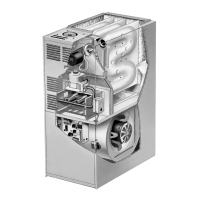3DJH
TABLE 2
IGNITION CONTROL A3 TERMINAL DESIGNATIONS
Terminal Type Function
GROUND 1/4 Spade Cabinet Ground
THS 2 1/4 Spade
Safety Limit 24VAC Input
From Rollout and Prove Switch
P.V.1
1/4 or
3/16Spade
24VAC Output to Pilot Operator
of Gas Valve
M.V.3
1/4 or 3/16
Spade
24VAC Output to Main Operator
of Gas Valve
SENSE 4 1/4 Spade Microamp Flame Sensing Input
Unmarked
Pin Type
Bare Wire
High Voltage Spark Output
Diagnostic LED
The furnace ignition control is equipped with a diagnostic
LED used for troubleshootingthe unit andthe control. LED
functions are shown in table 3.
TABLE 3
Furnace Control A3 Diagnostic LED
LED Stat
e
Meaning Remedy
Steady On
Normal Opera-
tion
----
Slow Flash
(1 sec. on/
5 sec. off)
Control Retry
Period
Failed to Sense Flame. Ignition
Control Will Retry
Before Locking Out.
Off
Control Failure
or Power Fail-
ure or Hard
Lockout
If Power and Gas Supply are OK,
Try Removing Tstat Demand For
At Least 30 Seconds. If LED Re-
mains Off When Demand Is Re-
turned, Replace Control.
Johnson G776 Ignition Control Operation
The information in this section is protected by a copyright issued by
Johnson Controls, Inc., and is reproduced with permission.
On a call for heat from the indoor thermostat, the ignition
control energizes and the ignition control LED lights
(steady on). The combustion air blower is energized. After
a 15 second pre-purge period, the control simultaneously
opens the pilot valve and sends spark to the pilot elec-
trode.
If the pilot ignites within 85 seconds, the flame sensor de-
tects pilot flame and signals the ignition control to to ener-
gize the main valve. The main valve cannot be energized
until the sensor detects pilot flame. Spark continues until
pilot flame is sensed or 85 seconds has elapsed, whichev-
er happens first.
When pilot flame is sensed, the main valve is energized
and the spark turns off. The ignition control remains in
“run” mode until the indoor thermostat is satisfied or flame
is lost.
If pilot flame is not sensed before the end of the 85 second
trial for ignition, the control enters the 100% shutoff mode.
The spark circuit and pilot valve de-energize and the igni-
tion control automatically begins the 60 minute retry delay
period. During the 60 minute delay the diagnostic LED
continually flashes on for one second and off for five se-
conds. After the delay period, another trial for ignition se-
quence starts, beginning with pre-purge.
If pilotflame goes out while theindoor thermostat is calling
for heat, both main and pilot valves de-energize within 0.8
seconds and remain de-energized for five seconds. After
this delay, the spark and pilot valve energize until flame is
sensed or the85second trial for ignitionperiodends.Ifthis
“flameout” cycle repeats 16 times (pilot flame is estab-
lished and then lost), the control locks out and the LED
goes off. A new trial for ignition sequence begins after the
thermostat contacts are opened for 30 seconds and then
closed.
If flame is detected when the thermostat calls for heat, it
must extinguish within 30 seconds for normal operation. If
flameis still present after 30 seconds, the control goes into
lockout and the LED goes off.
D-Combustion Air Blower (B6)
All G23(X) units use a combustion air blower to move air
through the burners and heat exchanger during heating op-
eration. The blower uses a shaded pole 120VAC motor.
Shaded pole motors do not use run capacitors. The motor
operates during all heating operation and is controlled by
blower control A15. The blower operates continuously while
there is a call for heat. The ignition control is prevented from
proceeding through the ignition sequence until combustion
air blower operation is sensed by the prove switch.
The pressure switch connected to the upper vest panel is
used to prove combustion air blower operation. The switch
monitors air pressure in the blower housing. During normal
operation, the pressure in the housing is negative. If the
pressure drops (becomes more positive), the pressure
switch opens. When the pressure switch opens, the ignition
control (A3) immediately closes the gas valve to prevent
burner operation.

